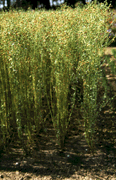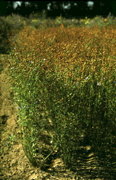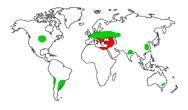Flax (Linum usitatissimum L.)
Flax family
(Linaceae)

| 
|
| Fibre flax | Linseed
|
Source: Kalda M., MPI Köln
Distribution, Yield, Use:
-
Distribution:
The most important areas for production are in Europe,
ex-USSR, China, India, North America and Argentina.
Few soil requirements, but high water usage.
Linseed prefers a warmer climate with less humidity
than fibre flax.
-
Yield:
5 - 20 dt seeds /ha
5 - 25 dt fibres /ha
-
Use:
- Seed oil for varnish, dyes, linoleum,
cooking oil,
pressing residues as animal fodder
- Seeds
for nutritional and medicinal use
- Stem fibres
as raw material for textile industry.
Seeds contain 38 - 45% oil,
rich in linoleic and linolenic acids.

Region of origin:  Region of cultivation:
Region of cultivation: 
-
Cultivation and Breeding:
Flax belongs with barley and wheat to the oldest cultivated plants. It was already grown 6000 - 8000 years ago in Egypt and Sumeria and came to Southern mid-Europe in the early Stone Age (3000 BC). L.angustifolium, the narrow-leafed perennial wild type with bursting capsules, which came to the mediterranean from South West Asia, is viewed as the ancestral form. Varieties have been developed by selection which are suited for the production of oil (with closed capsules), fibres and mixed production. Examples of these different varieties already occur in the oldest cultures.
-
Breeding aims:
The principle aims are the improvement of the yield and quality of the oil and fibres. Varieties with long, thick unbranched stems and high fibre content are desirable qualities for fibre production. Oil producing varieties should be rather low-growing and free-flowering as a prerequisite for having a high number of capsules per plant. Other factors to be taken into account, according to the particular industrial requirements, are the seed size, oil content and composition. New varieties strive for an optimal combination of both types of use.
Text by
Dr. Wolfgang Schuchert
Adapted to HTML by R.Saedler



 Region of cultivation:
Region of cultivation: 